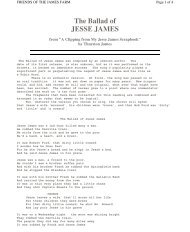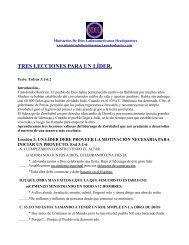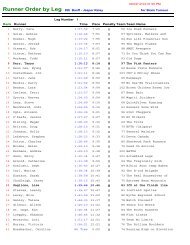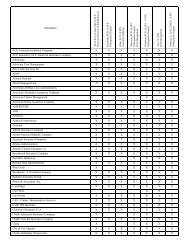icr graduates — a cause for celebration
icr graduates — a cause for celebration
icr graduates — a cause for celebration
Create successful ePaper yourself
Turn your PDF publications into a flip-book with our unique Google optimized e-Paper software.
detected only in real design. Since<br />
intent is a hallmark of intelligence<br />
and is not a characteristic of natural<br />
environments, its presence allows a<br />
clear distinction <strong>for</strong> <strong>for</strong>mulating questions,<br />
such as what best explains a bat’s<br />
wings<strong>—</strong>are they a suitably specified<br />
feature intended <strong>for</strong> flight, or a purposeless<br />
retooling of <strong>for</strong>elegs into wings?<br />
Environmental Processes Cannot Fashion<br />
Intricately Arranged Parts<br />
The existence of complex biological features<br />
allows a test <strong>for</strong> their origins. This test only<br />
needs careful observation. However, it must be<br />
done right. Since the origination of how living<br />
things operate<strong>—</strong>especially their ability to generate<br />
diverse offspring<strong>—</strong>is the issue in dispute,<br />
ensure that it is not used as part of the explanation<br />
in any way. Stay alert to the evolutionist’s<br />
habit of appealing to the living world’s capabilities<br />
to explain its own origination. Thus, the<br />
<strong>cause</strong> of biological complexity <strong>for</strong> creationists<br />
is an intelligent mind, while <strong>for</strong> evolutionists it<br />
is chance coupled to environmental elements<br />
(sunlight, wind, rain, gravity, etc.).<br />
The test is best utilized in conversation.<br />
Everyone should describe observations where<br />
environmental elements produce even two interconnected<br />
parts. Some chemical processes<br />
have a chance of going a few multiple steps.<br />
But, the discussion will make apparent the severe<br />
limitations of environmental elements<strong>—</strong><br />
devoid of the living world’s in<strong>for</strong>mation.<br />
Evolutionists correctly assert that natural<br />
processes alone can produce ordered arrangements.<br />
After molten aluminum cools, atoms<br />
naturally align into ordered lattices. But only<br />
after being worked into specifically shaped and<br />
precisely arranged parts can aluminum become<br />
a complex engine. While an ordered status has<br />
more structure than a chaotic one, it is far from<br />
the status of many intricately arranged parts.<br />
Thus, comparing order to biological complexity<br />
is irrelevant.<br />
Many evolutionists claim the poor<br />
quality of living creatures proves they are not<br />
designed. But this is also beside the point.<br />
Human-designed items range in quality from<br />
careless to extremely fine. Words describing<br />
quality, such as “seamless,” “blemish free,” or<br />
“durable,” are qualifiers that add weight to correctly<br />
perceiving patterns of design<strong>—</strong>but so do<br />
words like “crude” or “sloppy.” Quality in itself<br />
is not the sign of intellectual activity. Several<br />
points flow from this fact: 1) Genuine design<br />
does not demand anything be of the best quality;<br />
2) in their prime, living things normally<br />
do exhibit breathtaking fit and finish; and<br />
3) environmental elements alone do not<br />
achieve even shoddy design<strong>—</strong>since they cannot<br />
produce any design.<br />
Learning a Short Example<br />
A March 2010 episode of the popular series<br />
Life on the Discovery Channel was about<br />
mammals. On the origin of bats, it stated, “Up<br />
close it’s easy to see that this is a mammal. Bats<br />
evolved about 50 million years ago, probably<br />
from a small squirrel-like mammal that had<br />
learned to glide through the air. From there it<br />
was only a hop, skip, and a jump to true flight.” 4<br />
Is this, or Dr. Coyne’s account of how “selection<br />
simply retooled” a shrew, what someone should<br />
actually believe about bats?<br />
Helping someone recognize obvious patterns<br />
of design<strong>—</strong>in just the bat’s wing<strong>—</strong>may<br />
provide a more realistic explanation. Bat wings<br />
integrate unique properties in regard to composition,<br />
shape, and movement. In flight, tremendously<br />
elastic wing skin is cyclically folded close<br />
to the body, then rapidly extended in precisely<br />
coordinated motions. Extremely synchronized<br />
rapid twitch muscles deftly modulate bone interactions<br />
at dozens of joints, allowing subtle<br />
alterations of wing shape. Thus, at slow speeds,<br />
bats generate more lift and greater maneuverability<br />
than many birds. Even evolutionary descriptions<br />
of the supposedly earliest bat fossils,<br />
Onychonycteris finneyi or Icaronycteris, are like<br />
living bats in every aspect<strong>—</strong>though a few fea-<br />
tures were scraped together that they envision<br />
to be “primitive.” 5<br />
Pulling It All Together<br />
Helping someone discover patterns of<br />
design can be exciting. A brief description<br />
could be:<br />
When I drive my car, I observe many organized<br />
features that are patterns consistent<br />
with design. There are interdependent<br />
parts and lots of moving parts, arranged in<br />
a particular order, with very precise shape,<br />
alignment, and timing. A single human<br />
cell has the same precise fit and timing,<br />
but also finely-tuned feedback loops <strong>for</strong><br />
self regulation, a materials packaging and<br />
delivery system, a m<strong>icr</strong>oscopic railway system,<br />
hundreds of communication pathways,<br />
and in<strong>for</strong>mation stored, retrieved,<br />
and translated as a functioning language.<br />
Features like these are only found in human-designed<br />
items and living things. No<br />
known environmental elements alone can<br />
produce such interconnected parts.<br />
I recently saw a program where the origination<br />
of these things all the way up to<br />
flight abilities of bats was portrayed as<br />
very simple. If you start looking <strong>for</strong> the<br />
word “simple” in evolution-based education,<br />
you may be shocked at how often it<br />
is used. Simple changes made to simple<br />
creatures are more easily believed, but in<br />
real life biologically complex entities have<br />
many intricately arranged parts that are<br />
functionally interconnected to satisfy an<br />
intended purpose. The best explanation<br />
<strong>for</strong> this still remains the infinite power<br />
of the Lord Jesus Christ, who packed all<br />
of this complexity into creatures whose<br />
workmanship stands unequaled.<br />
References<br />
1. Darwin, C. 1859. On the origin of species. London: John Murray,<br />
218<br />
2. Coyne, J. The Improbability Pump. The Nation, May 10,<br />
2010.<br />
3. The Wistar Institute Symposium at Philadelphia, PA, in<br />
April 1966 was the first <strong>for</strong>um in which mathematicians<br />
exchanged findings challenging Darwinian theory. See<br />
Schützenberger, M. 1967. Algorithms and the neo-darwinian<br />
theory of evolution. Mathematical Challenge to the<br />
Neodarwinian Theory of Evolution. Monograph No. 5 Wistar<br />
Institute Press, 73-80. See also Hoyle, F. 1984. The Intelligent<br />
Universe. New York: Holt, Rinehart and Winston, 17.<br />
4. Life: Mammals. First aired<br />
on Discovery Channel on<br />
March 28, 2010.<br />
5. Simmons, N. et al. 2008.<br />
Primitive Early Eocene<br />
bat from Wyoming and<br />
the evolution of flight and<br />
echolocation. Nature. 451<br />
(7180): 818-821.<br />
Dr. Guliuzza is ICR’s<br />
National Representative.<br />
JULY 2010 • ACTS&FACTS<br />
11
















